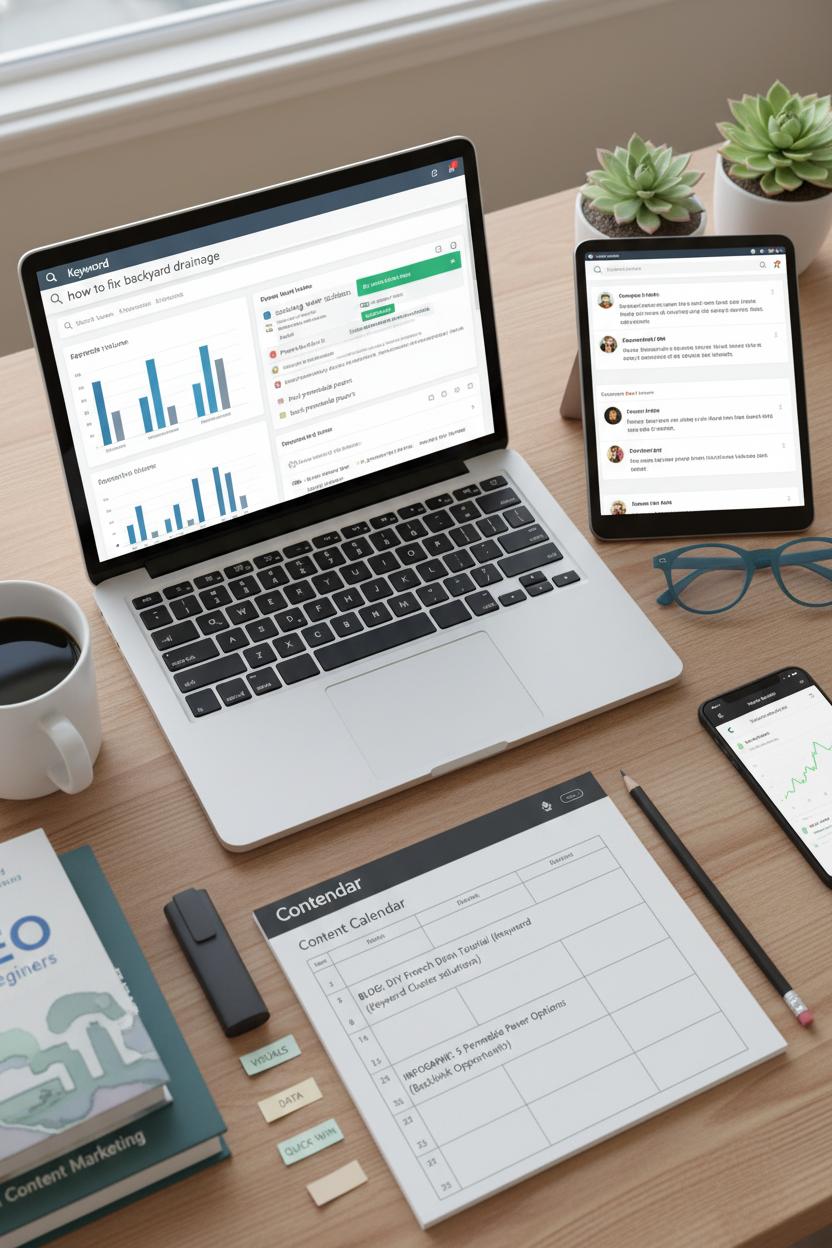Ready to climb the SERPs? This beginner-friendly guide shares proven SEO tips to boost your Google ranking in 7 simple steps. Learn search engine optimization essentials—from smart keyword research and on-page SEO tweaks to a sustainable backlink strategy. We’ll point you to must-read SEO books, a reliable keyword research tool, and a website analytics tool to track wins. Plus, grab a content marketing book rec to power small business marketing. Pin this for later and start optimizing today!
Master the basics of search engine optimization: SEO tips to kick-start your Google ranking

Think of search engine optimization as staging your website the way you’d style a cozy living room for guests: a few thoughtful touches make people want to stay. Start with intention by getting clear on the questions your audience is typing into Google, then use a keyword research tool to map those phrases to a single page with one main idea. From there, polish the essentials of on-page SEO: write a clear, click-meet-expectations title tag, a friendly meta description, skimmable H1–H3 headers, and image alt text that actually describes what’s shown. Weave your keywords naturally into the first 100 words and sprinkle internal links where they help readers go deeper. Keep paragraphs breathable, URLs short, and pages fast and mobile-first. These small, consistent SEO tips create the kind of structure Google loves—and they make your content easier to enjoy.
Content still wears the crown, so publish pieces that solve a real problem in your readers’ day, add a dash of personality, and close with a simple next step. If you’re feeling stuck, flip through a couple of up-to-date SEO books or a content marketing book for inspiration and examples. Aim for evergreen posts you can refresh seasonally, adding new stats, FAQs, and visuals. If you’re focused on small business marketing, craft location-specific pages and sprinkle in those neighborhood details that signal local relevance, like landmarks, service areas, and real customer stories.
To build authority, develop a sustainable backlink strategy rooted in relationships and usefulness: share irresistible how-to guides, data roundups, or templates that others naturally want to reference; partner with complementary brands; pitch guest posts; and list your site in credible directories. Track what’s working with a website analytics tool so you can see which pages climb in Google ranking and which need a lift with better internal links or fresher content. When you combine audience-first writing, tidy technical basics, and thoughtful promotion, you’ll create a steady momentum that compounds over time—one optimized page, one helpful post, one quality link at a time. And if you need a little extra nudge, keep a short stack of bookmarked resources and an SEO checklist at hand—think a reliable keyword research tool and a couple of practical guides alongside your favorite morning coffee.
Find profitable keywords with a keyword research tool

Before you write a single headline, cozy up with a good keyword research tool and let it guide your content calendar like a mood board for search. Start with the phrases your customers actually use—peek at your DMs, reviews, and FAQs, then pop those seed terms into the tool and explore the related queries, questions, and long-tails it suggests. You’re looking for that sweet spot where people are searching often enough to matter, but competition isn’t sky-high. Think problem-first phrases (“how to fix…”, “best…for…”) and location modifiers if you’re doing small business marketing. This is where search engine optimization feels less technical and more like being a great listener—tuning into intent so you can answer beautifully and fast.
As you sift, check three signals: search volume, keyword difficulty, and intent. Long-tail phrases with clear intent often convert better and are easier wins for your Google ranking. Click into the live results to see who’s ranking and what they’re offering—lists, tutorials, comparisons—and let that shape your on-page SEO plan. Group your keywords into tight themes and map each to a specific page or post so every URL has a clear purpose. When you spot a cluster that begs for visuals or data, flag it—those are gift-wrapped opportunities for your backlink strategy, because useful assets attract links naturally. Sprinkle in quick-win topics for momentum and a few ambitious targets for growth; a balanced mix keeps traffic rising while you build authority.
If you’re new to this, a quick flip through beginner-friendly SEO books or a practical content marketing book can sharpen your instincts, and a solid website analytics tool will confirm what’s working so you can double down. Many keyword platforms show seasonality, SERP features, and competitor gaps—peek at rivals to find phrases they missed or underserved angles you can own. Keep a running list of content ideas right inside your tool, star the “profitables,” and schedule them thoughtfully. The best SEO tips aren’t flashy: pick keywords you can genuinely satisfy, craft the most helpful page on the internet for that query, and keep iterating as the data rolls in. That’s the quiet, consistent path to sustainable traffic.
Publish standout content: apply lessons from a content marketing book

If your goal is to publish content that feels like a beautifully styled pin—eye-catching, useful, and worth saving—borrow a few pages from your favorite content marketing book. Start with intent. Before you draft a single sentence, pop open a keyword research tool and listen for questions your reader is already whispering to Google. Pick one problem, promise a transformation, and outline a clear path from A to B. Then layer in simple SEO tips: use your primary phrase in the title and intro, keep your subheads descriptive, and sprinkle related terms where they naturally fit. Think storytelling plus teachable structure—open with a relatable scene, deliver the steps, then close with a quick recap so the post feels satisfying and complete. This is search engine optimization that reads like a conversation, not a checklist.
Make it skimmable and sensory. Use strong H2s, short sections, and examples your audience can picture in their morning coffee window. A good content marketing book will remind you to add “proof moments”—screenshots, mini case studies, or a quick template download—so your piece earns trust and saves time. For small business marketing, aim for helpful specificity: exact scripts, numbers, timelines. That’s how you nail on-page SEO without sounding robotic. I love dog-earing SEO books for headline formulas and intro frameworks; they’re gold when you’re stuck. And don’t forget visuals—original charts, a simple checklist graphic, or a before-and-after photo can make your post irresistibly shareable.
Finally, line up promotion and measurement like a tidy desk. Build a gentle backlink strategy into your plan: publish something citeable (a data roundup, a comparison table, a how-to with unique images), then let relevant bloggers, newsletters, and communities know it exists. Internally link from older posts, and answer comments to keep the page alive. Check a website analytics tool weekly to see which sections get the most love and where readers drop off, then update the post with clearer steps or fresh stats. With this rhythm—intent, structure, proof, and smart promotion—you’ll create content that genuinely helps, lifts your Google ranking, and compounds over time. And the best part? Every post teaches you something new you can pour into the next one.
Boost speed and UX, and measure with a website analytics tool

Think of your website like a sunlit boutique: if the door sticks and the floor feels cluttered, people won’t linger—no matter how lovely the products. Speed is that door, and UX is the layout. Start by trimming the digital fluff: compress and lazy-load images (WebP is your friend), minify CSS/JS, use a CDN, and keep plugins lean. Swap heavy sliders for a single hero image, defer non-critical scripts, and choose system or variable fonts to shave off precious seconds. On mobile, keep tap targets roomy and forms short—thumb-friendly wins. These small, steady upgrades are classic SEO tips because they’re really about people first, bots second. And yes, this is on-page SEO at its most practical: a faster, clearer page earns more reads, more saves, and more shares, which nudges your Google ranking in the right direction.
Great UX also means a path that feels intuitive. Use scannable headings, generous white space, high-contrast text, and descriptive buttons that make the next step feel obvious. Keep pop-ups polite and optional. Think buttery-smooth scrolling and pages that load above the fold in a heartbeat. Google’s Core Web Vitals reward this kind of polish because search engine optimization is ultimately about delighting the visitor. The bonus? A site that feels effortless attracts organic mentions, which quietly supports your backlink strategy without begging for links—people naturally reference resources that made their lives easier.
Now measure the magic. Set up a website analytics tool to watch what’s working: track page speed metrics (LCP, INP, CLS), top landing pages, bounce and exit rates, and conversion paths. Peek at site search terms to spot content gaps and tag campaigns so you know which pins, emails, or Reels actually move the needle. Check mobile vs. desktop behavior, and run simple A/B tests on headlines or buttons to turn “pretty good” into “wow.” If you love learning by osmosis, browse a few SEO books or a content marketing book for pattern-breaking ideas, and keep a keyword research tool handy to prioritize what to optimize next. For founders knee-deep in small business marketing, create a weekly ritual: make one UX tweak, test it with your website analytics tool, and rinse-repeat. That momentum compounds—quietly, beautifully, sustainably.
Build authority with a sustainable backlink strategy

Think of links from other sites like little word-of-mouth notes that say, “Hey, this brand is worth your time.” A sustainable backlink strategy isn’t about swapping links or chasing spammy directories; it’s about showing up with content people actually want to reference. Start by creating linkable assets that feel Pinterest-pretty and truly helpful—comprehensive how-to guides, templates, local resource lists, original mini-studies, and story-rich case studies. Use a keyword research tool to spot the questions everyone is asking but no one is answering well. Pair that with strong on-page SEO so your pieces are easy to crawl, fast, and clearly organized. This blend of thoughtful creation and clean structure is the quiet engine behind search engine optimization, helping your work earn mentions naturally and lifting your Google ranking over time.
Next, make friends, not just links. Pitch guest contributions to complementary blogs, offer expert quotes to journalists and podcasters, and share helpful testimonials for tools you genuinely use. Join industry communities, sponsor a local meetup, or collaborate on a co-branded checklist—classic small business marketing moves that also win relevant, trustworthy links. Turn unlinked mentions into wins by politely asking writers to credit your brand, and circle back to older posts across the web with a quick note when your updated guide genuinely adds value. Anchor your outreach in service: What fresh data, visuals, or how-to steps does your piece contribute? If you need a confidence boost or frameworks for pitching, browse a few SEO books or a content marketing book for examples and email templates that don’t feel salesy.
Keep your cadence gentle and consistent. A handful of thoughtful pitches each week compounds faster than one frantic blast. Track what resonates using a website analytics tool—watch referral traffic, new linking domains, and assisted conversions to see which partnerships deserve a second date. Jot insights into a simple tracker so you can repeat what works and retire what doesn’t. Among all the SEO tips you’ll hear, remember this: the best backlink strategy is an outcome of generosity. When your content genuinely helps, the web responds in kind, and those organic nods of trust quietly carry your brand higher, month after month.
Scale wins for small business marketing and keep improving Google ranking with top SEO books

Scaling your small business marketing doesn’t mean doing more; it means doing the right things on repeat. Start by building a cozy little system you’ll actually stick to: a weekly content sprint where you sip something warm, open your favorite keyword research tool, and map out three search-friendly topics your audience already cares about. Draft one anchor post and two supporting pieces, then polish the on-page SEO like you’re styling a shelf—clear headings, keyword-aligned subheads, descriptive image alt text, and internal links that guide readers deeper. As you publish, keep a living checklist of SEO tips taped to your desktop: title tag length, meta description clarity, page speed notes, and one simple call-to-action per page. These tiny habits compound, and that’s where the scale magic happens.
To keep your Google ranking inching upward, treat learning as part of the workflow, not an afterthought. Keep a small stack of SEO books within reach and make a date with one chapter each week. You’ll pick up practical patterns you can apply the same day—how to refine a backlink strategy without spamming, how to structure topic clusters, how to balance readability with search engine optimization, and when to refresh an older article instead of writing a new one. Pair that mini-study session with your website analytics tool: glance at which pages are climbing, which keywords are almost there, and which posts earned new links. If you’re more story-driven, rotate in a content marketing book to spark ideas for visuals, headlines, and seasonal angles that feel fresh yet strategic for small business marketing.
The rhythm is simple and sustainable: learn, implement, measure, repeat. Repurpose your best-performing post into a pin, a short video, and an email teaser, each pointing back to the same optimized page. Nurture a few genuine partnerships every month to earn natural mentions that support your backlink strategy. Once a quarter, run a gentle site tidy—fix a slow image, update a stat, add a clearer intro—so your on-page SEO stays crisp. Over time, those small, loving tweaks create a flywheel: better content signals, stronger engagement, steadier rankings. Keep showing up, keep refining, and let your library of SEO books and tools whisper what to do next.
Conclusion
Consider this your cozy cup of SEO confidence. With simple SEO tips—smart keywords, clean on-page SEO, helpful content, speedy pages, internal links, and a thoughtful backlink strategy—your search engine optimization foundation is set. Keep consistency, measure results, and watch your Google ranking rise, one small tweak at a time. Light a candle, schedule your next audit, and pin these steps for later; small, steady moves make big visibility magic. You’ve got this—now go polish a page, earn a link, and celebrate every climb!